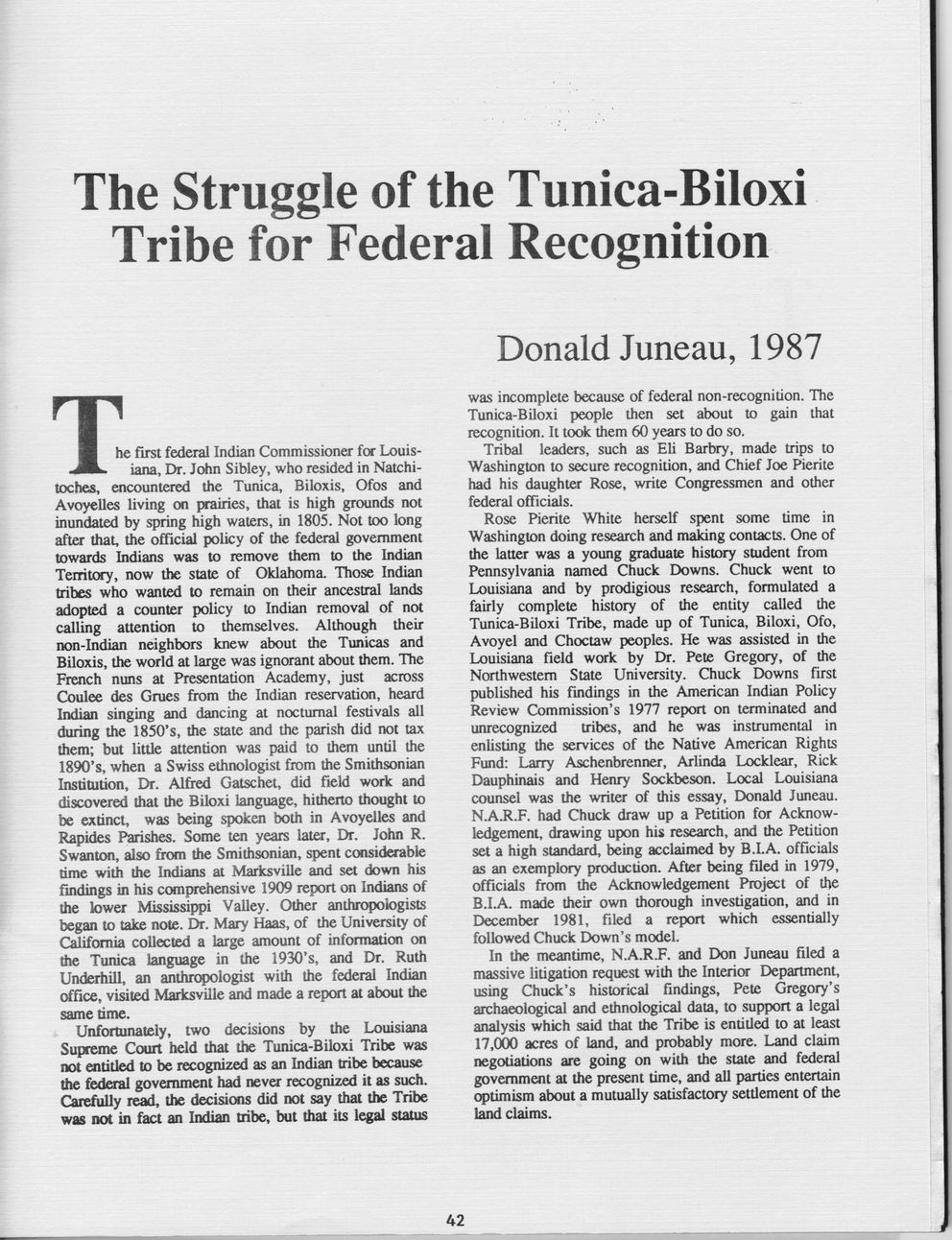This text was obtained via automated optical character recognition.
It has not been edited and may therefore contain several errors.
The Struggle of the Tunica-Biloxi Tribe for Federal Recognition Donald Juneau, 1987 T ■ he first federal Indian Commissioner for Louis-iana, Dr. John Sibley, who resided in Natchitoches, encountered the Tunica, Biloxis, Ofos and Avoyelles living on prairies, that is high grounds not inundated by spring high waters, in 1805. Not too long after that, the official policy of the federal government towards Indians was to remove them to the Indian Territory, now the state of Oklahoma. Those Indian tribes who wanted to remain on their ancestral lands adopted a counter policy to Indian removal of not calling attention to themselves. Although their non-Indian neighbors knew about the Tunicas and Biloxis, the world at large was ignorant about them. The French nuns at Presentation Academy, just across Coulee des Grues from the Indian reservation, heard Indian singing and dancing at nocturnal festivals all during the 1850’s, the state and the parish did not tax them; but little attention was paid to them until the 1890’s, when a Swiss ethnologist from the Smithsonian Institution, Dr. Alfred Gatschet, did field work and discovered that the Biloxi language, hitherto thought to be extinct, was being spoken both in Avoyelles and Rapides Parishes. Some ten years later, Dr. John R. Swanton, also from the Smithsonian, spent considerable time with the Indians at Marksville and set down his findings in his comprehensive 1909 report on Indians of the lower Mississippi Valley. Other anthropologists began to take note. Dr. Mary Haas, of the University of California collected a large amount of information on the Tunica language in the 1930’s, and Dr. Ruth Underhill, an anthropologist with the federal Indian office, visited Marksville and made a report at about the same time. Unfortunately, two decisions by the Louisiana Supreme Court held that the Tunica-Biloxi Tribe was not entitled to be recognized as an Indian tribe because the federal government had never recognized it as such. Carefully read, the decisions did not say that the Tribe was not in fact an Indian tribe, but that its legal status was incomplete because of federal non-recognition. The Tunica-Biloxi people then set about to gain that recognition. It took them 60 years to do so. Tribal leaders, such as Eli Barbry, made trips to Washington to secure recognition, and Chief Joe Pierite had his daughter Rose, write Congressmen and other federal officials. Rose Pierite White herself spent some time in Washington doing research and making contacts. One of the latter was a young graduate history student from Pennsylvania named Chuck Downs. Chuck went to Louisiana and by prodigious research, formulated a fairly complete history of the entity called the Tunica-Biloxi Tribe, made up of Tunica, Biloxi, Ofo, Avoyel and Choctaw peoples. He was assisted in the Louisiana field work by Dr. Pete Gregory, of the Northwestern State University. Chuck Downs first published his findings in the American Indian Policy Review Commission’s 1977 report on terminated and unrecognized tribes, and he was instrumental in enlisting the services of the Native American Rights Fund: Larry Aschenbrenner, Arlinda Locklear, Rick Dauphinais and Henry Sockbeson. Local Louisiana counsel was the writer of this essay, Donald Juneau. N.A.R.F. had Chuck draw up a Petition for Acknowledgement, drawing upon his research, and the Petition set a high standard, being acclaimed by B.I.A. officials as an exemplory production. After being filed in 1979, officials from the Acknowledgement Project of the B.I.A. made their own thorough investigation, and in December 1981, filed a report which essentially followed Chuck Down’s model. In the meantime, N.A.R.F. and Don Juneau filed a massive litigation request with the Interior Department, using Chuck’s historical findings, Pete Gregory’s archaeological and ethnological data, to support a legal analysis which said that the Tribe is entitled to at least 17,000 acres of land, and probably more. Land claim negotiations are going on with the state and federal government at the present time, and all parties entertain optimism about a mutually satisfactory settlement of the land claims. 42

Native Americans The-Tunica-Biloxi-Tribe-its-Culture-and-People-(52)